化学学报 ›› 2023, Vol. 81 ›› Issue (10): 1357-1370.DOI: 10.6023/A23050210 上一篇 下一篇
研究论文
郑冰*( ), 王喆†, 何静†, 张姣, 戚文博, 张梦圆, 于海涛*(
), 王喆†, 何静†, 张姣, 戚文博, 张梦圆, 于海涛*( )
)
投稿日期:2023-05-06
发布日期:2023-06-27
作者简介:基金资助:
Bing Zheng( ), Zhe Wang†, Jing He†, Jiao Zhang, Wenbo Qi, Mengyuan Zhang, Haitao Yu(
), Zhe Wang†, Jing He†, Jiao Zhang, Wenbo Qi, Mengyuan Zhang, Haitao Yu( )
)
Received:2023-05-06
Published:2023-06-27
Contact:
*E-mail: About author:Supported by:文章分享

功函可调硼烯基电极材料可有效提升载流子的迁移效率, 因此对于最大化器件的能量转换效率及性能至关重要. 基于第一性原理密度泛函理论, 研究了碱(土)金属吸附双层α-硼烯(M/DBBP; M=Li~Cs; Be~Ba)纳米复合材料的几何、稳定性、电子结构和功函随M电离能(IP)的变化规律. 结果表明, 所研究的10个M/DBBP体系均是热、动力学稳定的. M/DBBP体系的M—B键长、结合能、吸附原子与DBBP之间的电子转移和功函均与吸附原子IP呈(近)线性关系. 由于Li和Be的尺寸非常小, 其大幅增加的M—B成键区域导致Li/DBBP和Be/DBBP的结合能偏离了与其吸附原子IP之间的线性关系. 由于Ca/DBBP中层间区域形成了独特的多中心键, 使得Ca/DBBP的层间相互作用强度显著高于其余9个体系. M/DBBP保持了金属性, 碱(土)金属原子与DBBP之间的成键方式均为离子键. 此外, 吸附原子向基体转移的电荷数和诱导偶极矩均随吸附原子IP的减小而增加, 是碱(土)金属/DBBP功函降低的主要原因. 本研究揭示了M/DBBP复合体的几何、稳定性、电子结构和功函的变化规律, 为深入认识上述科学问题, 以及实验上设计功函可调的硼烯基电极材料提供理论依据.
郑冰, 王喆, 何静, 张姣, 戚文博, 张梦圆, 于海涛. 碱(土)金属/双层α-硼烯纳米复合体的结构和功函性质的理论研究[J]. 化学学报, 2023, 81(10): 1357-1370.
Bing Zheng, Zhe Wang, Jing He, Jiao Zhang, Wenbo Qi, Mengyuan Zhang, Haitao Yu. Structure and Work Function of Alkaline (Earth) Metal-Bilayer α-Borophene Nanocomposite: A Theoretical Study[J]. Acta Chimica Sinica, 2023, 81(10): 1357-1370.






| Structure | D/nm | Da/nm | L/nm | $\bar{L}_{1~3}$/nm | $\bar{L}_{1~4}$/nm | Ref. | |||
|---|---|---|---|---|---|---|---|---|---|
| L1 | L2 | L3 | L4 | ||||||
| DBBP | 0.154 | 0.286 | — | — | — | — | — | — | [ |
| DBBP | 0.154 | 0.286 | 0.180 | 0.180 | 0.190 | — | 0.184 | 0.184 | This study |
| Li/DBBP | 0.147 | 0.260 | — | — | — | — | — | — | [ |
| Li/DBBP | 0.152 | 0.281 | 0.180 | 0.182 | 0.179 | 0.202 | 0.181 | 0.186 | This study |
| Na/DBBP | 0.151 | 0.287 | 0.180 | 0.184 | 0.179 | 0.198 | 0.181 | 0.185 | This study |
| K/DBBP | 0.151 | 0.281 | 0.180 | 0.184 | 0.179 | 0.198 | 0.181 | 0.185 | This study |
| Rb/DBBP | 0.151 | 0.276 | 0.180 | 0.184 | 0.179 | 0.197 | 0.181 | 0.185 | This study |
| Cs/DBBP | 0.155 | 0.283 | 0.181 | 0.186 | 0.179 | 0.197 | 0.182 | 0.186 | This study |
| Be/DBBP | 0.145 | 0.264 | 0.178 | 0.186 | 0.190 | 0.193 | 0.185 | 0.187 | This study |
| Mg/DBBP | 0.151 | 0.281 | 0.181 | 0.183 | 0.177 | 0.191 | 0.180 | 0.183 | This study |
| Ca/DBBP | 0.155 | 0.261 | 0.187b | 0.175 | 0.176 | 0.203 | 0.179 | 0.185 | This study |
| Sr/DBBP | 0.137 | 0.272 | 0.181 | 0.178 | 0.180 | 0.194 | 0.179 | 0.183 | This study |
| Ba/DBBP | 0.146 | 0.289 | 0.181 | 0.182 | 0.177 | 0.191 | 0.180 | 0.183 | This study |
| Structure | D/nm | Da/nm | L/nm | $\bar{L}_{1~3}$/nm | $\bar{L}_{1~4}$/nm | Ref. | |||
|---|---|---|---|---|---|---|---|---|---|
| L1 | L2 | L3 | L4 | ||||||
| DBBP | 0.154 | 0.286 | — | — | — | — | — | — | [ |
| DBBP | 0.154 | 0.286 | 0.180 | 0.180 | 0.190 | — | 0.184 | 0.184 | This study |
| Li/DBBP | 0.147 | 0.260 | — | — | — | — | — | — | [ |
| Li/DBBP | 0.152 | 0.281 | 0.180 | 0.182 | 0.179 | 0.202 | 0.181 | 0.186 | This study |
| Na/DBBP | 0.151 | 0.287 | 0.180 | 0.184 | 0.179 | 0.198 | 0.181 | 0.185 | This study |
| K/DBBP | 0.151 | 0.281 | 0.180 | 0.184 | 0.179 | 0.198 | 0.181 | 0.185 | This study |
| Rb/DBBP | 0.151 | 0.276 | 0.180 | 0.184 | 0.179 | 0.197 | 0.181 | 0.185 | This study |
| Cs/DBBP | 0.155 | 0.283 | 0.181 | 0.186 | 0.179 | 0.197 | 0.182 | 0.186 | This study |
| Be/DBBP | 0.145 | 0.264 | 0.178 | 0.186 | 0.190 | 0.193 | 0.185 | 0.187 | This study |
| Mg/DBBP | 0.151 | 0.281 | 0.181 | 0.183 | 0.177 | 0.191 | 0.180 | 0.183 | This study |
| Ca/DBBP | 0.155 | 0.261 | 0.187b | 0.175 | 0.176 | 0.203 | 0.179 | 0.185 | This study |
| Sr/DBBP | 0.137 | 0.272 | 0.181 | 0.178 | 0.180 | 0.194 | 0.179 | 0.183 | This study |
| Ba/DBBP | 0.146 | 0.289 | 0.181 | 0.182 | 0.177 | 0.191 | 0.180 | 0.183 | This study |


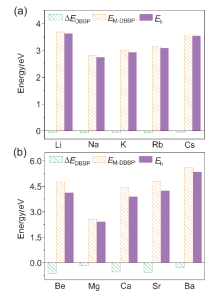

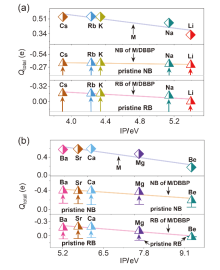

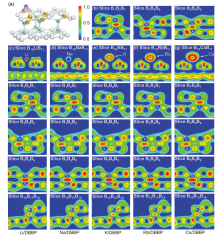

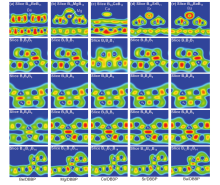

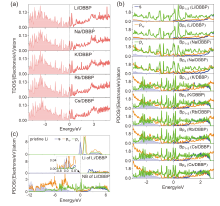

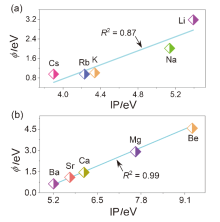

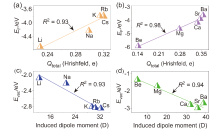

| [1] |
Zhang, Z.; Lin, P.; Liao, Q.; Kang, Z.; Si, H.; Zhang, Y. Adv. Mater. 2019, 31, 1806411.
doi: 10.1002/adma.v31.37 |
| [2] |
Zhang, D.; Yuan, Z.; Zhang, G.; Tian, N.; Liu, D.; Zhang, Y. Acta Chim. Sinica 2018, 76, 537 (in Chinese).
doi: 10.6023/A18040175 |
|
(张丹丹, 袁振洲, 张国庆, 田楠, 刘丹敏, 张永哲, 化学学报, 2018, 76, 537.)
|
|
| [3] |
Chang, Z.-W.; Meng, F.-L.; Zhong, H.-X.; Zhang, X.-B. Chin. J. Chem. 2018, 36, 287 (in Chinese).
doi: 10.1002/cjoc.v36.4 |
|
(常志伟, 孟樊露, 钟海霞, 张新博, 中国化学, 2018, 36, 287.)
|
|
| [4] |
Yuan, Z.; Liu, D.; Tian, N.; Zhang, G.; Zhang, Y. Acta Chim. Sinica 2016, 74, 488 (in Chinese).
doi: 10.6023/A16010035 |
|
(袁振洲, 刘丹敏, 田楠, 张国庆, 张永哲, 化学学报, 2016, 74, 488.)
|
|
| [5] |
Han, Y.; Geng, Z.; Wang, Y.; Liang, J.; Yan, P. Acta Chim. Sinica 2009, 67, 773 (in Chinese).
|
|
(韩彦霞, 耿志远, 王永成, 梁俊玺, 闫盆吉, 化学学报, 2009, 67, 773.)
|
|
| [6] |
Zhang, L.; Gao, S.; Liu, W.; Tang, R.; Shang, N.; Wang, C.; Wang, Z. Chin. J. Org. Chem. 2014, 34, 1542 (in Chinese).
doi: 10.6023/cjoc201403001 |
|
(张丽, 高书涛, 刘伟华, 唐然肖, 商宁昭, 王春, 王志, 有机化学, 2014, 34, 1542.)
|
|
| [7] |
Seo, J.-T.; Bong, J.; Cha, J.; Lim, T.; Son, J.; Park, S. H.; Hwang, J.; Hong, S.; Ju, S. J. Appl. Phys. 2014, 116, 084312.
doi: 10.1063/1.4894392 |
| [8] |
Kwon, K. C.; Choi, K. S.; Kim, S. Y. Adv. Funct. Mater. 2012, 22, 4724.
doi: 10.1002/adfm.v22.22 |
| [9] |
Jia, T.; Zheng, N.; Cai, W.; Ying, L.; Huang, F. Acta Chim. Sinica 2017, 75, 808 (in Chinese).
doi: 10.6023/A17030114 |
|
(贾涛, 郑楠楠, 蔡万清, 应磊, 黄飞, 化学学报, 2017, 75, 808.)
|
|
| [10] |
Zhang, K.; Guan, X.; Huang, F.; Cao, Y. Acta Chim. Sinica 2012, 70, 2489 (in Chinese).
doi: 10.6023/A12100777 |
|
(张凯, 管星, 黄飞, 曹镛, 化学学报, 2012, 70, 2489.)
|
|
| [11] |
Wang, B.; Gunther, S.; Wintterlin, J.; Bocquet, M. L. New J. Phys. 2010, 12, 043041.
doi: 10.1088/1367-2630/12/4/043041 |
| [12] |
Shin, H.-J.; Choi, W. M.; Choi, D.; Han, G. H.; Yoon, S.-M.; Park, H.-K.; Kim, S.-W.; Jin, Y. W.; Lee, S. Y.; Kim, J. M.; Choi, J.-Y.; Lee, Y. H. J. Am. Chem. Soc. 2010, 132, 15603.
doi: 10.1021/ja105140e |
| [13] |
Bae, G.; Cha, J.; Lee, H.; Park, W.; Park, N. Carbon 2012, 50, 851.
doi: 10.1016/j.carbon.2011.09.044 |
| [14] |
Das, A.; Pisana, S.; Chakraborty, B.; Piscanec, S.; Saha, S. K.; Waghmare, U. V.; Novoselov, K. S.; Krishnamurthy, H. R.; Geim, A. K.; Ferrari, A. C.; Sood, A. K. Nat. Nanotechnol. 2008, 3, 210.
doi: 10.1038/nnano.2008.67 |
| [15] |
Wang, Y.; Tong, S. W.; Xu, X. F.; Özyilmaz, B.; Loh, K. P. Adv. Mater. 2011, 23, 1514.
doi: 10.1002/adma.v23.13 |
| [16] |
Chan, K. T.; Neaton, J. B.; Cohen, M. L. Phys. Rev. B 2008, 77, 235430.
doi: 10.1103/PhysRevB.77.235430 |
| [17] |
Legesse, M.; Rashkeev, S. N.; Al-Dirini, F.; Alharbi, F. H. Appl. Surf. Sci. 2020, 509, 144893.
doi: 10.1016/j.apsusc.2019.144893 |
| [18] |
Legesse, M.; Mellouhi, F. E.; Bentria, E. T.; Madjet, M. E.; Fisher, T. S.; Kais, S.; Alharbi, F. H. Appl. Surf. Sci. 2017, 394, 98.
doi: 10.1016/j.apsusc.2016.10.097 |
| [19] |
Sherpa, S. D.; Levitin, G.; Hess, D. W. Appl. Phys. Lett. 2012, 101, 111602.
doi: 10.1063/1.4752443 |
| [20] |
Cho, H.; Dae Kim, S.; Han, T.-H.; Song, I.; Byun, J.-W.; Kim, Y.-H.; Kwon, S.; Bae, S.-H.; Cheul Choi, H.; Ahn, J.-H.; Lee, T.-W. 2D Mater. 2014, 2, 014002.
doi: 10.1088/2053-1583/2/1/014002 |
| [21] |
Hao, J.-H.; Wang, Z.-J.; Wang, Y.-F.; Yin, Y.-H.; Jiang, R.; Jin, Q.-H. Solid State Sci. 2015, 50, 69.
doi: 10.1016/j.solidstatesciences.2015.10.015 |
| [22] |
Taylor, P. D.; Osborne, D. A.; Tawfik, S. A.; Morishita, T.; Spencer, M. J. S. Phys. Chem. Chem. Phys. 2019, 21, 7165.
doi: 10.1039/C9CP00424F |
| [23] |
Wang, L.; Gao, J.; Ding, F. Acta Chim. Sinica 2014, 72, 3.
|
|
(王璐, 高俊峰, 丁峰, 物理化学学报, 2014, 72, 3.)
|
|
| [24] |
Xu, Z.; Li, Y.; Shi, P.; Wang, B.; Huang, X. Chin. J. Org. Chem. 2013, 33, 2162 (in Chinese).
doi: 10.6023/cjoc201306011 |
|
(徐志远, 李永军, 史萍, 王博婵, 黄晓宇, 有机化学, 2013, 33, 2162.)
|
|
| [25] |
Wang, Q.; Xue, M.; Zhang, Z. Acta Phy.-Chim. Sinica 2019, 35, 565 (in Chinese).
|
|
(王琴, 薛珉敏, 张助华, 物理化学学报, 2019, 35, 565.)
|
|
| [26] |
Zheng, B.; He, J.; Wang, Z.; Xie, Y.; Qian, Y.-Y.; Zhang, J.; Tang, Y.-N.; Cui, L.-Y.; Wu, Y.-M.; Yang, L.; Yu, H.-T. Appl. Surf. Sci. 2023, 612, 155842.
doi: 10.1016/j.apsusc.2022.155842 |
| [27] |
Kistanov, A. A.; Cai, Y.; Zhou, K.; Srikanth, N.; Dmitriev, S. V.; Zhang, Y.-W. Nanoscale 2018, 10, 1403.
doi: 10.1039/C7NR06537J |
| [28] |
Qian, Y.; Zheng, B.; Xie, Y.; He, J.; Chen, J.; Yang, L.; Lu, X.; Yu, H. Langmuir 2021, 37, 11027.
doi: 10.1021/acs.langmuir.1c01598 |
| [29] |
Zheng, B.; Yu, H.; Xie, Y.; Lian, Y. ACS Appl. Mater. Inter. 2014, 6, 19690.
doi: 10.1021/am504674p |
| [30] |
Yi, T.; Zheng, B.; Yu, H.; Xie, Y. Chem. Res. Chin. Univ. 2017, 33, 631.
doi: 10.1007/s40242-017-7038-5 |
| [31] |
Zheng, B.; Xie, Y.; Deng, Y.; Wang, Z.; Lou, Y.; Qian, Y.; He, J.; Yu, H. Adv. Theory Simul. 2020, 3, 1900249.
doi: 10.1002/adts.v3.5 |
| [32] |
Deng, Y.; Qian, Y.; Xie, Y.; Zhang, L.; Zheng, B.; Lou, Y.; Yu, H. Acta Chim. Sinica 2020, 78, 344 (in Chinese).
doi: 10.6023/A19120455 |
|
(邓颖怡, 钱银银, 谢颖, 张磊, 郑冰, 娄原青, 于海涛, 化学学报, 2020, 78, 344.)
|
|
| [33] |
Liu, X.; Li, Q.; Ruan, Q.; Rahn, M. S.; Yakobson, B. I.; Hersam, M. C. Nat. Mater. 2021, 21, 35.
doi: 10.1038/s41563-021-01084-2 |
| [34] |
Chen, C.; Lv, H.; Zhang, P.; Zhuo, Z.; Wang, Y.; Ma, C.; Li, W.; Wang, X.; Feng, B.; Cheng, P.; Wu, X.; Wu, K.; Chen, L. Nature Chemistry 2022, 14, 25.
doi: 10.1038/s41557-021-00813-z |
| [35] |
Chhetri, P.; Ackermann, D.; Backe, H.; Block, M.; Cheal, B.; Droese, C.; Dullmann, C. E.; Even, J.; Ferrer, R.; Giacoppo, F.; Gotz, S.; Hessberger, F. P.; Huyse, M.; Kaleja, O.; Khuyagbaatar, J.; Kunz, P.; Laatiaoui, M.; Lautenschlager, F.; Lauth, W.; Lecesne, N.; Lens, L.; Minaya Ramirez, E.; Mistry, A. K.; Raeder, S.; Van Duppen, P.; Walther, T.; Yakushev, A.; Zhang, Z. Phys. Rev. Lett. 2018, 126, 263003.
|
| [36] |
Saidi, W. A. Cryst. Growth Des. 2015, 15, 3190.
doi: 10.1021/acs.cgd.5b00269 |
| [37] |
Xu, S.-F.; Yuan, G.; Li, C.; Liu, W.-H.; Mimura, H. J. Phys. Chem. C 2011, 115, 8928.
doi: 10.1021/jp200885m |
| [38] |
Galeev, T. R.; Chen, Q.; Guo, J.; Bai, H.; Miao, C.; Lu, H.; Sergeeva, A. P.; Li, S.; Boldyrev, A. I. Phys. Chem. Chem. Phys. 2011, 13, 11575.
doi: 10.1039/c1cp20439d |
| [39] |
Perdew, J. P.; Burke, K.; Ernzerhof, M. Phys. Rev. Lett. 1996, 77, 3865.
doi: 10.1103/PhysRevLett.77.3865 |
| [40] |
Tkatchenko, A.; DiStasio, R. A., Jr.; Car, R.; Scheffler, M. Phys. Rev. Lett. 2012, 108, 236402.
doi: 10.1103/PhysRevLett.108.236402 |
| [41] |
Monkhorst, H. J.; Pack, J. D. Phys. Rev. B 1976, 13, 5188.
doi: 10.1103/PhysRevB.13.5188 |
| [42] |
Zhang, H.; Xu, Z. P.; Lu, G. Q.; Smith, S. C. J. Phys. Chem. C 2010, 114, 12618.
doi: 10.1021/jp102724s |
| [43] |
Egger, D. A.; Liu, Z.-F.; Neaton, J. B.; Kronik, L. Nano Lett. 2015, 15, 2448.
doi: 10.1021/nl504863r |
| [44] |
Zheng, B.; Yu, H. T.; Lian, Y. F.; Xie, Y. Chem. Phys. Lett. 2016, 648, 81.
doi: 10.1016/j.cplett.2016.01.074 |
| [45] |
He, J.; Zheng, B.; Xie, Y.; Qian, Y. Y.; Zhang, J.; Wang, K.; Yang, L.; Yu, H. T. Phys. Chem. Chem. Phys. 2022, 24, 8923.
doi: 10.1039/D2CP00506A |
| [46] |
Kaneti, Y. V.; Benu, D. P.; Xu, X.; Yuliarto, B.; Yamauchi, Y.; Golberg, D. Chem. Rev. 2022, 122, 1000.
doi: 10.1021/acs.chemrev.1c00233 |
| [47] |
Tang, H.; Ismail-Beigi, S. Phys. Rev. Lett. 2007, 99, 115501.
doi: 10.1103/PhysRevLett.99.115501 |
| [48] |
Banerjee, S.; Periyasamy, G.; Pati, S. K. J. Mater. Chem. A 2014, 2, 3856.
doi: 10.1039/c3ta14041e |
| [49] |
Khanifaev, J.; Pekoz, R.; Konuk, M.; Durgun, E. Phys. Chem. Chem. Phys. 2017, 19, 28963.
doi: 10.1039/C7CP05793H |
| [50] |
Zhang, H. ACS Nano 2015, 9, 9451.
doi: 10.1021/acsnano.5b05040 |
| [51] |
Bezugly, V.; Kunstmann, J.; Grundkötter-Stock, B.; Frauenheim, T.; Niehaus, T.; Cuniberti, G. ACS Nano 2011, 5, 4997.
doi: 10.1021/nn201099a |
| [52] |
Shan, B.; Cho, K. Phys. Rev. Lett. 2005, 94, 236602.
doi: 10.1103/PhysRevLett.94.236602 |
| [53] |
Liu, F.; Shen, C.; Su, Z.; Ding, X.; Deng, S.; Chen, J.; Xu, N.; Gao, H. J. Mater. Chem. 2010, 20, 2197.
doi: 10.1039/b919260c |
| [54] |
Lin, H.; Shi, H.; Wang, Z.; Mu, Y.; Li, S.; Zhao, J.; Guo, J.; Yang, B.; Wu, Z.; Liu, F. ACS Nano 2021, 15, 17327.
doi: 10.1021/acsnano.1c04961 |
| [55] |
Ranjan, P.; Sahu, T. K.; Bhushan, R.; Yamijala, S. S. R. K. C.; Late, D. J.; Kumar, P.; Vinu, A. Adv. Mater. 2019, 31, 1900353.
doi: 10.1002/adma.v31.27 |
| [56] |
Li, H.; Jing, L.; Liu, W.; Lin, J.; Tay, R. Y.; Tsang, S. H.; Teo, E. H. T. ACS Nano 2018, 12, 1262.
doi: 10.1021/acsnano.7b07444 |
| [57] |
Chahal, S.; Ranjan, P.; Motlag, M.; Yamijala, S. S. R. K. C.; Late, D. J.; Sadki, E. H. S.; Cheng, G. J.; Kumar, P. Adv. Mater. 2021, 33, 2102039.
doi: 10.1002/adma.v33.34 |
| [58] |
Wu, X.; Dai, J.; Zhao, Y.; Zhuo, Z.; Yang, J.; Zeng, X. ACS Nano 2012, 6, 7443.
doi: 10.1021/nn302696v |
| [59] |
Huang, J. H.; Fang, J. H.; Liu, C. C.; Chu, C. W. ACS Nano 2011, 5, 6262.
doi: 10.1021/nn201253w |
| [1] | 李宁, 徐丽娜, 方国勇, 马英晋. 结合容错编码的量子化学分布式计算[J]. 化学学报, 2024, 82(2): 138-145. |
| [2] | 林航青, 马若茹, 江怡蓝, 许木榕, 林洋彭, 杜克钊. 用于卤素捕获的材料研究进展[J]. 化学学报, 2024, 82(1): 62-74. |
| [3] | 张凯, 武晓君. 具有室温铁磁性的二维Janus钛硫属化物★[J]. 化学学报, 2023, 81(9): 1142-1147. |
| [4] | 韩玉淳, 王毅琳. 长效抗菌材料的研究现状与展望★[J]. 化学学报, 2023, 81(9): 1196-1201. |
| [5] | 梁雪峰, 荆剑, 冯昕, 赵勇泽, 唐新员, 何燕, 张立胜, 李慧芳. 共价有机框架COF66/COF366的电子结构: 从单体到二维平面聚合物[J]. 化学学报, 2023, 81(7): 717-724. |
| [6] | 王凯晴, 袁硕, 徐王东, 霍丹, 杨秋林, 侯庆喜, 于得海. ZIF-8@B-CNF复合气凝胶的制备及其吸附性能研究[J]. 化学学报, 2023, 81(6): 604-612. |
| [7] | 李子奇, 刘力玮, 毛承晖, 周常楷, 夏旻祺, 沈桢, 郭月, 吴强, 王喜章, 杨立军, 胡征. 钴取代多金属氧酸盐作为可溶性介质提升锂硫电池性能[J]. 化学学报, 2023, 81(6): 620-626. |
| [8] | 曾少娟, 孙雪琦, 白银鸽, 白璐, 郑爽, 张香平, 张锁江. CO2捕集分离的功能离子液体及材料研究进展★[J]. 化学学报, 2023, 81(6): 627-645. |
| [9] | 赵振新, 姚一琨, 陈佳骏, 牛蓉, 王晓敏. 一种高熵磷酸盐正极宿主实现高稳定性锂硫电池[J]. 化学学报, 2023, 81(5): 496-501. |
| [10] | 蒋江民, 郑欣冉, 孟雅婷, 贺文杰, 陈亚鑫, 庄全超, 袁加仁, 鞠治成, 张校刚. 氟氮共掺杂多孔碳纳米片的制备及其储钾性能研究[J]. 化学学报, 2023, 81(4): 319-327. |
| [11] | 王文涛, 赖欣婷, 闫士全, 朱雷, 姚玉元, 丁黎明. 双功能气凝胶吸附-降解协同处理染料废水[J]. 化学学报, 2023, 81(3): 222-230. |
| [12] | 赵政嘉, 刘康, 郭燕, 于吉攀, 石伟群. 超铀金属有机化学研究进展[J]. 化学学报, 2023, 81(11): 1633-1641. |
| [13] | 刘芳, 潘婷婷, 任秀蓉, 鲍卫仁, 王建成, 胡江亮. HCDs@MIL-100(Fe)吸附剂的制备及其苯吸附性能研究[J]. 化学学报, 2022, 80(7): 879-887. |
| [14] | 李晓倩, 张靖, 苏芳芳, 王德超, 姚东东, 郑亚萍. 多孔离子液体的构筑及应用[J]. 化学学报, 2022, 80(6): 848-860. |
| [15] | 吕天天, 马文, 詹冬笋, 邹燕敏, 李继龙, 冯美玲, 黄小荥. 两例新的镧系金属-有机框架化合物高效去除Cs+离子研究※[J]. 化学学报, 2022, 80(5): 640-646. |
| 阅读次数 | ||||||
|
全文 |
|
|||||
|
摘要 |
|
|||||